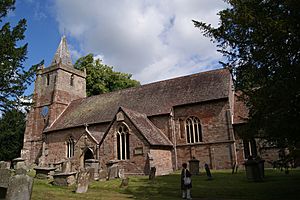St Mary's Church, Dymock facts for kids
St Mary's Church, Dymock is an old and important church in the village of Dymock, Gloucestershire, England. It belongs to the Church of England. This church is so special that it's listed as a Grade I listed building. This means it's a very important historic building.
Contents
History of St Mary's Church
The main part of St Mary's Church was built a very long time ago, during the Norman period. This was around the 11th and 12th centuries. The church is even mentioned in the famous Domesday Book, which was written in 1086 AD.
The tall tower of the church was added much later, in the 15th century. In the 1800s, the church was repaired and updated. This work is called a "Victorian restoration" and was done by an architect named John Middleton.
Protecting the Church
Today, St Mary's Church is on a special list called the Historic England Heritage at risk register. This means that parts of the church, like the stone on the tower and its supports (called buttresses), are slowly wearing away. Being on this list helps the church get attention and funding for repairs.
The church is part of a group of churches in the area. This group includes churches from Redmarley D'Abitot, Bromesberrow, Pauntley, and Upleadon. They all work together within the Diocese of Gloucester, which is a larger church area.
Dymock's Special Sculptors
Dymock is famous for a special group of artists from the Middle Ages. These artists created amazing stone carvings in a style called Romanesque sculpture. This style was popular in Europe from about 1000 to 1200 AD.
A historian named George Zarnecki first wrote about these sculptures in 1950. Later, a Reverend named John Eric Gethyn-Jones studied them more closely. He named this group of artists after Dymock Church. This is because St Mary's Church has many examples of their unique carvings. You can also find their work in other churches nearby.
What the Church Looks Like
St Mary's Church has a long main hall called a nave, which was built in the 12th century. At the west end, there's a tall tower from the 15th century. On top of the tower is a short, eight-sided spire that looks like a pyramid.
The church also has different parts sticking out. There's a porch on the south side, which is like an entrance room. Next to it, on the east, is a small south chapel. There's also a north chapel, but it's further west than the south one.
Inside the Church
Inside, you can see many examples of Romanesque architecture. This style uses round arches and thick walls. You can spot it in the church's doorways and windows. The tower also has a special stone band called a stringcourse.
At the back of the nave, there's a display about the Dymock poets. These were a group of famous poets who lived in the Dymock area in the early 1900s. The church also has a special memorial. It remembers the brave men from Dymock who lost their lives in World War I and World War II.


